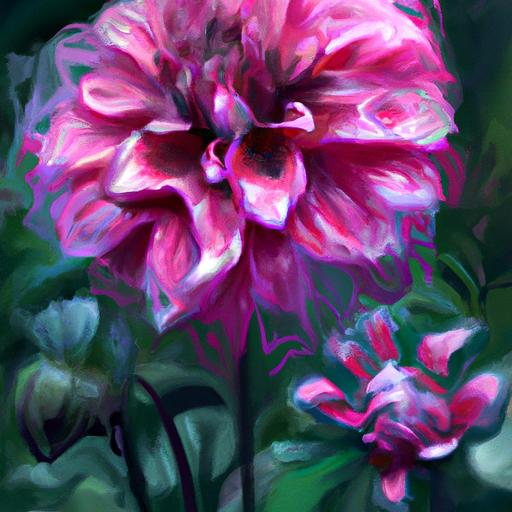Do you have a dahlia plant with leaves covered in white spots? Have you been wondering what’s causing them? You’re not alone.
Many gardeners have been asking the same question.
In this article, we’ll answer the question of why dahlia leaves have white spots and provide helpful prevention tips.
We’ll look at the causes of white spots on dahlia leaves, including fungal infections, nutrient deficiencies, and insect infestations.
We’ll also discuss the importance of watering the plants, keeping garden hygiene, and doing regular inspections.
Read on to find out the answer to your dahlia mystery.
Table of Contents
Short Answer
White spots on dahlia leaves are likely caused by a fungal disease called powdery mildew.
This disease is caused by high humidity or overcrowded plants and can spread quickly.
To prevent it, make sure your dahlia plants have adequate space and air circulation, and that your soil is well-draining.
You may also want to consider using a fungicide to treat the plants.
What Causes White Spots on Dahlia Leaves?
The cause of white spots on dahlia leaves can be quite varied and is often dependent on the environment the plants are in.
Generally, these spots can be caused by a fungal infection, a nutrient deficiency, or an insect infestation.
Fungal infections are a common cause of white spots on dahlia leaves, and are typically caused by spores in the air.
The fungal spores settle on the leaves and cause the spots to appear.
The best way to prevent this from happening is to keep the dahlia plants well-watered, as this will help to keep the spores from settling on the leaves.
Additionally, good garden hygiene is important, as this will help to keep the area around the plants free from pests and fungi.
Nutrient deficiencies can also cause white spots on dahlia leaves.
If the plants are lacking in certain essential nutrients, such as nitrogen, phosphorus, or potassium, then the leaves may become discolored and develop white spots.
To prevent this from happening, it is important to use a good quality fertilizer that is specifically designed for dahlia plants.
Finally, insect infestations can also cause white spots on dahlia leaves.
Common pests such as aphids, mealybugs, and thrips can all affect dahlia plants, and can cause discoloration and white spots on the leaves.
To prevent this from happening, it is important to regularly inspect the leaves for any signs of infestation.
If any are found, then it is important to take immediate action to remove the pests.
With proper care, white spots on dahlia leaves can be eliminated and your dahlia flowers will be able to thrive.
Regular watering, good garden hygiene, and regular inspections of the leaves can all help to ensure that your plants stay healthy and free from disease.
Additionally, using a good quality fertilizer specifically designed for dahlia plants can help to ensure that the plants get all the nutrients they need to remain strong and healthy.
Fungal Infections

Fungal infections are one of the most common causes of white spots on dahlia leaves.
The most common fungal pathogen responsible for these spots is a type of powdery mildew known as Golovinomyces cichoracearum.
This fungus is spread through airborne spores and thrives in warm, wet weather.
As it grows, it produces a white, powdery substance on the leaves, which causes the white spots.
If left unchecked, this fungus can spread to other plants and cause significant damage.
To prevent fungal infections, gardeners should practice good garden hygiene.
This means removing any dead or diseased leaves and avoiding overcrowding of plants.
Additionally, plants should be kept well-watered and given plenty of air circulation to prevent fungal growth.
Applying a fungicide may also be necessary if the infection has already started.
Regular inspections of the leaves can help identify any problems early on and prevent them from worsening.
Nutrient Deficiencies
Nutrient deficiencies can be one of the main causes of white spots on dahlia leaves.
If the soil around the plants is lacking in essential minerals and nutrients, the leaves can become discolored and take on a white, spotted appearance.
This is because the plant is unable to take up enough nutrition from the soil to remain healthy and vibrant.
To prevent this from happening, it is important to regularly fertilize the soil with a balanced fertilizer that contains all the necessary elements.
Additionally, soil testing can help identify any nutrient deficiencies and allow gardeners to adjust their fertilization schedule accordingly.
With the right nutrition, dahlia plants will have the energy to keep their leaves healthy and free from white spots.
Insect Infestations

When it comes to why do my dahlia leaves have white spots, one possible cause is an insect infestation.
Insects such as aphids and whiteflies can cause white spots to form on dahlia leaves.
These spots are usually small and powdery in appearance and can be found in clusters.
These pests feed on the sap of the plant, which can lead to a weakened state and yellowing or discoloration of the leaves.
Additionally, the pests can excrete a sticky substance that can further contribute to the white spots and discoloration of the leaves.
To prevent insect infestations, it is important to practice good garden hygiene.
This includes regularly inspecting the plants for signs of insect activity and removing any debris or old leaves that could provide harborage for pests.
Additionally, using an appropriate insecticide can help control any existing infestations.
It is also important to note that some insecticides can be harmful to beneficial insects, so it is important to use caution when applying them.
Finally, keeping the dahlia plants well-watered and fertilized can help to keep them strong and healthy, making them less susceptible to insect infestations.
Prevention Tips
When it comes to preventing white spots on dahlia leaves, its important to practice good garden hygiene and to keep the plants well-watered.
Watering the plants regularly helps to keep the foliage moist and discourage the growth of any fungal infections that may be responsible for these white spots.
Additionally, its important to inspect the leaves of the dahlia plants regularly to keep an eye out for any signs of trouble.
Insect infestations can also be a cause of white spots on dahlia leaves, so its important to keep an eye out for any signs of pests.
If you notice any signs of pests, its important to take action quickly to prevent them from spreading to other plants in your garden.
Additionally, using natural pest repellents or organic insecticides can help to protect your dahlias from any unwanted visitors.
Finally, a lack of certain nutrients can also be to blame for white spots on dahlia leaves.
Ensuring that your dahlia plants are getting all the nutrients they need can help to prevent this issue from occurring.
Regularly adding organic matter to your soil and using a slow-release fertilizer can help to keep your dahlia plants healthy and thriving.
By following these simple steps, you can help to keep your dahlia plants free from white spots and ensure they stay healthy and vibrant for years to come.
Watering the Plants

Watering the plants is one of the most important steps in keeping dahlia leaves healthy and free from white spots.
It is essential to keep the soil evenly moist, but not wet, as too much moisture can cause the leaves to become more susceptible to fungal infections.
Watering should be done early in the morning or late in the evening to give the plants time to dry out before the sun is too hot.
Additionally, adding mulch around the plants can help retain moisture and keep the soil cool.
By making sure that the dahlia plants are properly watered, the risk of fungal infections, nutrient deficiencies, and insect infestations can be greatly reduced.
Garden Hygiene
Garden hygiene is essential for keeping your dahlia plants healthy and happy.
Taking the time to practice good hygiene habits can go a long way in preventing white spots on the leaves.
Start by removing any dead or decaying foliage from the plant, as these can become breeding grounds for fungal infections and insect infestations.
Additionally, be sure to regularly inspect the leaves for signs of damage or discoloration.
If you find any, treat them as soon as possible to stop the issue from spreading.
Another important part of garden hygiene is to make sure the dahlia plants are properly watered.
Keeping the soil consistently moist will help the plants absorb the nutrients they need to stay healthy.
However, its important to avoid overwatering, as this can also lead to fungal growth and other problems.
Additionally, fertilizing the plants with a balanced fertilizer every few months can help provide them with the nutrients they need to stay strong and healthy.
Finally, take the time to regularly check for pests on the dahlia plants.
Aphids, thrips, and other insects can be attracted to the dahlia flowers, and can cause white spots on the leaves.
If you find any, its important to take the necessary steps to remove them right away.
This could involve using a pesticide or simply picking them off with your fingers.
By taking the time to practice good garden hygiene, you can help prevent white spots on the dahlia leaves and keep your plants healthy and happy.
With a bit of effort and regular inspections, you can keep your dahlia plants looking beautiful for years to come.
Regular Inspections

Regular inspections of the dahlia leaves can help identify any issues early on, allowing gardeners to take preventive measures and ensure their plants are healthy.
Inspections should be completed on a regular basis, ideally once a week or every other week, to check for any signs of disease or pest infestation.
When inspecting the leaves, look for discoloration, wilting, yellowing, or spots.
Spotting these signs early can help stop the spread of disease and reduce the risk of further damage.
Additionally, it is important to look for any signs of pests, such as aphids, caterpillars, slugs, or beetles, which can be removed by hand or with natural pest control methods.
Regular inspections can also help you monitor the overall health of your dahlia plants and provide an early warning of any potential problems.
Final Thoughts
White spots on dahlia leaves can be an annoying problem, but with proper care and regular inspections, they can be prevented.
Fungal infections, nutrient deficiencies, and insect infestations are all common causes of white spots.
To eliminate these spots, its important to keep plants well-watered and practice good garden hygiene.
Armed with this knowledge, you can ensure your dahlia plants look their best and bring lasting beauty to your garden.

